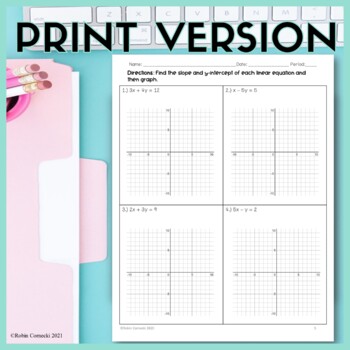Standard Form of a Linear Equation Guided Notes
- Zip
- Google Apps™
- Microsoft OneDrive

Description
Are your students learning about the Standard Form of a Linear Equation? This digital and printable Slope and y-intercept investigation will teach your students how to determine if a linear equation is in standard form, and will also help them understand slope and y-intercept when a linear equation is written in standard form.
This resource is perfect for Distance Learning (zero prep) or in the classroom. It can be used with Google™ or Microsoft™. You will receive a pdf with the printables, a link to the google slides, a PowerPoint version, and an answer key.
You must have a free Google™ account to access the Google™ slides.
⭐ These worksheets can be used digitally or as a hands-on investigation with the provided pdf handouts included.⭐
In this investigation, students will review/learn the standard form of a linear equation. Students will identify whether a linear equation is in standard form and if it isn’t then they will rearrange (solve) the equation so that it is in standard form.
Students will then look at 2 methods for finding slope and y-intercept when a linear equation is in standard form.
The first method is prior knowledge that the students should already be familiar with, which is rearranging the standard form into the slope-intercept form by solving the equation for y. After the equation is solved, students will identify the slope and y-intercept of the equation.
The second method is looking at the standard form and labeling the A, B, and C (coefficients and constants) and the slope and the y-intercepts from the first method.
The investigation part comes from looking at the relationships between the “A”, “B” and “m”, and the “B”, “C” and “b” by writing formulas for finding the slope and the y-intercept without rearranging the equation.
There is also a reflection question asking which method they prefer and why.
Lastly, there are practice problems for them to use their new formula to find the slope and y-intercept. They can also graph them if you choose and this could also lead to discussions on x-intercepts as well.
This investigation is perfect for letting students use mathematical reasoning through inquiry when we want students to discover something on their own, rather than just telling them what the formula is. Please note all y-intercepts in this investigation are integers.
I would also copy pages 3 and 4 separately so the students can look at method 2 while they are answering the investigation questions.
⭐ Please note in this investigation the definition used for Standard Form is when the leading coefficient is positive.
You may also like:
- Relations and Functions Digital Activity
- Solving Absolute Value Inequalities Digital Activity
- Relations and Functions Graphic Organizer
Don't forget to leave a review to earn credit towards future resources at no extra cost to you!
Let's be social!





